Mantis Shrimp
Hemisquilla californiensis
What is Life?
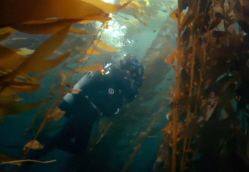
Kelp Forest, Catalina
These are the waters of Catalina, a tiny island 20 miles off the coast of Los Angeles, California. These are kelp forests, and they grow here in
tremendous abundance because the waters here around Catalina are rich in nutrients. That's because of the California currents, which brings this beautiful,
rich, cold water up from the depths of the Pacific and allows of this tremendous rich ecosystem to grow.
But I'm not here to marvel at these kelp forests. Beautiful as they are.
I'm here to search for the little animal that lives not in this forest of nutrients, but out there in the muddy ocean floor.
Mantis Shrimp - Hemisquilla californiensis
There he is, look! Can you see that?! Camouflaged in its burrow on the sea floor, the mantis shrimp is a seemingly unremarkable creature. It's not a
real shrimp, but a type of crustacean, called a stomatapod.
I've come to see it because in one way the mantis shrimp is truly extraordinary – the way it detects the world. You see these big… eyes that they
have to see.
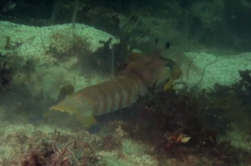
Mantis Shrimp - Hemisquilla californiensis
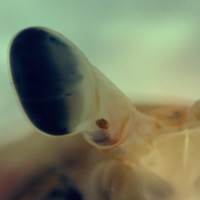
Multi-Facetted Eye
These are some of the most sophisticated eyes in the natural world. Each is made up of over 10,000 hexagonal lenses. And with twice as many
visual pigments as any other animal, it can see colours and the wavelengths of light that are invisible to me. These remarkable eyes give
the mantis shrimp a unique view of the ocean. And this is just one of the many finely-tuned senses that have evolved across the planet.
Sensing, the ability to detect and to react to the world outside, is fundamental to life. Every living thing is able to respond to its
environment. In this film, I want to show you how the senses developed, how the mechanisms that gather information about the outside world
evolved, how their emergence has helped animals thrive in different environments, and how the senses have pushed life in new directions,
and may ultimately have led to our own curiosity and intelligence.
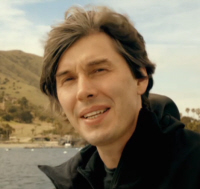
Professor Brian Cox
These are the woods of Kentucky, the first stop on a journey across America that will take me from the far west coast to the Atlantic,
through the heart of the country. It's the animals that I'll find on the way that will illuminate the world of the senses, and I'm going
to start by going the deep underground.
These are the Mammoth Caves in Kentucky. With over 300 miles of mapped passages, they're the longest cave system in the world. But this is
also the place to start exploring our own senses. We are normally dependent on our site, but down here in the darkness, it's a very different
world. And I have to rely on my other senses to build a picture of my environment.
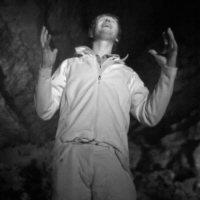
Prof. Brian Cox in cave
It's… completely dark in this cave. I can't see anything at all. You can see me because we are lighting it with infrared light. That's at a
wavelength that my eyes are completely insensitive to, so as far as I'm concerned, it is pitch black. And because it's so dark…
your other
senses become heightened, particularly hearing. It's virtually silent in here. But if you listen carefully… you can just hear the faint drop
of water from somewhere deep in the cave system. You'd never hear that if the cave were illuminated. But you focus on your hearing when it's
as dark as this.
As well as sight and hearing, we have of course a range of other senses. They're touch, which is a mixture of sensations – temperature
and pressure and pain – and then there are chemical senses, so smell and taste, and we share of those senses with almost every living thing
on the planet today, because they date back virtually to the beginning of life on Earth.
And even here, in water that's been collected from deep within the cave, there are organisms that are detecting and responding to their
environment in the same way that living things have been doing for over a billion years.




